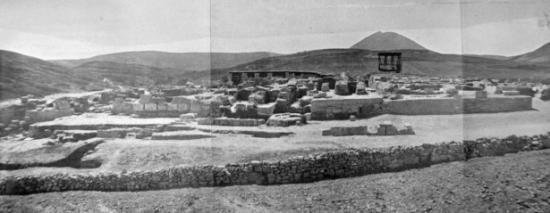Aegean Lecture by Peter Tomkins
Source - http://www.archaeology.wiki/blog/2015/01/19/piecing-together-puzzle-prepalatial-knossos/

Knossos, view from the North, 1901.
In the next Aegean Lecture entitled “Fragments of Complexity. Piecing together the puzzle of ‘Prepalatial’ Knossos (c. 3600-2000 BC)”, Peter Tomkins (University of Sheffield – Katholieke Universiteit Leuven) will explore the development of the Knossos community from the end of the Neolithic down to the end of the third millennium.
As explained in the abstract, around a century ago Arthur Evans began the task of writing up his excavations at Knossos. Whatever his initial intentions may have been, the resulting volumes of the Palace of Minos eschewed a conventional presentation of the site and its excavations in favour of a masterly synthesis of what Evans chose to call Minoan civilisation. Consequently, although Evans’ presentation of the Minoans was strongly influenced by (and seemingly grounded in) the evidence from Knossos, it has been by no means easy or straightforward for us to evaluate the empirical basis for his vision or to use his excavations to develop new interpretations. This is particularly the case for the crucial, but rather poorly understood period in the site’s occupation, between the end of the Neolithic and the beginning Middle Minoan period (c. 3600-2000 BC), during which it transformed from an egalitarian village to a stratified urban centre. Difficulties interpreting Evans’ excavations, combined with the generally limited number, nature and extent of EM exposures from more recent excavations, have rendered EM Knossos a puzzle of disconnected fragments. Thus for Knossos, as for many larger Early Minoan sites, it has proved impossible to assess the validity of two long-standing and partially opposing models of the emergence of more complex societies in the Aegean: namely a long, gradual evolution from the beginning of the Early Minoan period (Evans, Branigan, Warren) or a more rapid revolution around the beginning of the Middle Minoan period (Childe, Renfrew, Cherry). Closely bound up with each of these theories is the question of the origins and emergence of the so-called Minoan palaces. Did they emerge suddenly in the centuries around 2000 BC or did they evolve more slowly from origins much deeper in time?
Partly in an attempt to throw further light on these questions, the Knossos Kephala Project has spent the last decade assembling and relating all sources (published, archived, archaeological) relevant to the interpretation of Neolithic-MM contexts and their stratigraphy (vertical and horizontal) on the Palace Hill at Knossos. This task is being assisted by the creation of a site GIS and additional information has been provided by a geophysical survey (GPR, Direct Contact) of the hill conducted in 2009 and a re-survey of selected visible architecture (Total Station and DiffGPS).
While, inevitably, the puzzle of Prepalatial Knossos is still missing many pieces, the systematic assembly of all the fragments we possess allows a more specific picture of continuity and change in complexity to be sketched for each phase in this period.
This paper will explore the development of the Knossos community from the end of the Neolithic down to the end of the third millennium, tracing the transformation of the Kephala Hill from place of habitation to place of ceremony and attempting to address the thorny question of the origin of the monumental building complex, which, ever since Evans, we have called the ‘palace’.